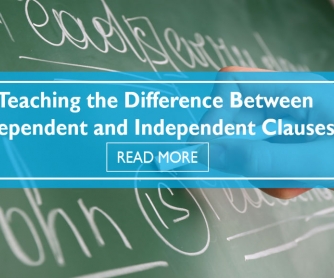
A clause is a group of related words that contains a subject and a verb, but it does not necessarily contain a complete thought. When it comes to teaching students about clauses, most teachers begin by separating clauses into two types: dependent clauses and independent clauses. The distinction between the two is fairly easy for advanced English speakers to spot, but for beginning and intermediate students, recognizing the difference between the two can be a bit difficult. And yet, knowing the difference between a dependent and independent clause is a key aspect of writing effective sentences and communicating ideas.
An independent clause can stand alone.
When you start teaching students about dependent and independent clauses, you can start with the idea that an independent clause can stand alone. Write an independent clause on a piece of paper and have a student stand at the front of the room and hold it. The sentence makes sense by itself. It does not need additional information to be complete.
Example: You must shower before entering the pool.
A dependent clause cannot stand alone.
A dependent clause, on the other hand, needs additional information to make sense. Write a dependent clause on a piece of paper and have a student stand at the front of the room and hold it. Instruct the student to fall down. Then have the class come up with an independent clause to support the dependent clause or provide an independent clause and have a student hold that clause and come help the dependent clause up.
Example: If you want to go swimming.
A dependent clause often begins with a subordinating conjunction.
Do you know what AAAWWUBBIS stands for? It's an awkward mnemonic device to help students recognize subordinating conjunctions. AAAWWUBBIS stands for although, after, as, when, while, until, before, because, if, since and represents some of the most commonly used subordinating conjunctions. Teach students that when they see these words, a sentence probably contains a dependent clause. If they start a sentence with one of these words, they need to check to see that the sentence contains a complete thought.
Example: Because they watched TV - incomplete thought
Example: Because they watched TV, they saw the latest weather report. - complete thought
A dependent clause is usually followed by a comma if it occurs at the beginning of a sentence.
Students can often also recognize dependent clauses because they are followed by a comma when they occur at the beginning of a sentence. However, dependent clauses do not often need commas when they occur at the end of a sentence.
Example: After eating too much pizza, the boy developed a stomachache.
Example: The boy developed a stomachache after eating too much pizza.
A dependent clause without an independent clause can lead to wild scenarios.
When teaching students about dependent and independent clauses, get a little creative. Provide students with dependent clauses and have them come up with crazy scenarios to support the dependent clauses.
Example: Since he started school.... his feet have grown three feet, his parents have moved to Hawaii, he has changed his name to Mr. Cuddles.
Example: Although I like mushrooms... I never wear them on my head, I only eat them with sprinkles, I always refuse to eat them.
An independent clause can be clarified with a dependent clause.
Even though an independent clause can stand alone, a dependent clause can add additional information. Give your students an independent clause and have them come up with dependent clauses to make the information in the independent clause more specific.
Example: We are having pizza for dinner. Because it is raining, we are having pizza for dinner. Since Mom doesn't feel like cooking, we are having pizza for dinner.
Example: The kids were crazy. While the play was starting, the kids were crazy. After they ate a bag of candy, the kids were crazy.
For more help teaching students about dependent and independent clauses, review Coordinate or Subordinate? Making Sense of English Conjunctions, Not All Clauses are Created Equal, and How to Teach Sentence Structure.
P.S. If you enjoyed this article, please help spread it by clicking one of those sharing buttons below. And if you are interested in more, you should follow our Facebook page where we share more about creative, non-boring ways to teach English.








